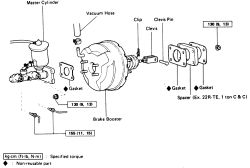The break booster is right behind the brake master cylinder (where you fill it with brake fluid). the brake booster brand new for my 4 runner was around $180
Test for a system vacuum leak as described below:
1. Operate the engine at idle without touching the brake pedal for at least one minute.
2. Turn off the engine, and wait one minute.
3. Test for the presence of assist vacuum by depressing the brake pedal and releasing it several times. Light application will produce less and less pedal travel, if vacuum was present. If there is no vacuum, air is leaking into the system somewhere.
Test for system operation as follows:
4. Pump the brake pedal (with engine off) until the supply vacuum is entirely gone.
5. Put a light, steady pressure on the pedal.
6. Start the engine, and operate it at idle. If the system is operating, the brake pedal should fall toward the floor if constant pressure is maintained on the pedal.
Power brake systems may be tested for hydraulic leaks just as ordinary systems are tested.
REMOVAL & INSTALLATION
See Figure 1
1. Remove the master cylinder as previously detailed.
2. Locate the clevis rod where it attaches to the brake pedal. Pull out the clip and then remove the clevis pin.
3. Disconnect the vacuum hose from the booster.
4. Loosen the four nuts and then pull out the vacuum booster, the bracket and the gasket.
Many 4WD models have two extra brackets that must be removed when removing the brake booster.
To install:
5. Install the booster and tighten the mounting bolts to 9 ft. lbs. (13 Nm).
6. Connect the clevis rod to the brake pedal.
7. Install the master cylinder. Check the brake pedal adjustment and bleed the brakes.

SPONSORED LINKS
Monday, April 12th, 2021 AT 10:04 AM
